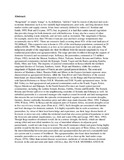| dc.description.abstract | “Rangeland” or simply “range” is, by
definition, “inferior” land by reason of physical
and socio-economic limitations such as low
rainfall, high temperatures, poor soils, and long
distances from market outlets and supply centres.
It has been variously defined by others (cf.
Stoddart and Smith, 1955; Pratt and Gwynne,
1977); but, in general, it is land that carries natural
vegetation that provides forage for both domestic
and wild herbivores. It may also be a source of
other products, including water, minerals, and
services such as recreation. The rangelands of
Kenya, for example, receive less than 750 mm
of rain per year and have average temperatures
that occasionally rise to 40°C. These are
extensive lands covering about 85% of the total
land area of 583,000km2. This expansive area is
home to 25% of the total human population,
estimated at 29 million (GOK, 1999). The density
is as low as two persons per km2 in the very arid
parts.
The indigenous people of the rangelands
eke their livelihood from the natural rangelands
by way of traditional pastoralism and
agropastoralism. The range provides livelihood
through the support of domestic livestock and
occasional crops. In Kenya, the pastoralists,
estimated at 3.5 million (Nopa, 1992), include
the Maasai, Samburu, Pokot, Turkana, Somali,
Borana and Gabbra. Some agropastoral
communities include the Kipsigis, Nandi, Tugen
and the Bantu speaking Kamba, Embu, Meru and
Taita.
The majority of pastoral communities in
Kenya inhabit the northern rangeland districts of
Turkana, Samburu, Isiolo, Wajir and Mandera,
while the southern rangelands of Kajiado and
parts of Narok are also typical pastoral districts.
The semi-arid districts of Machakos, Kitui,
Tharaka-Nithi and Mbere in the Eastern lowlands
represent areas characterised as agropastoral
districts, while the Tana River and Taita Districts
of the coastal hinterlands are characteristic
Development of and Policy on the Range and Pastoral Industry
with Special Reference to Kenya
N.K.R. Musimba and D.M. Nyariki
agropastoral areas. In the Rift Valley we find
agropastoral and pastoral communities such as
the Nandi, Tugen, Pokot, Elgeyo Marakwet and
Kipsigis. In the North Eastern Province are found
typical pastoral communities, including the
cushitic Somali, Borana, Gabbra, Oromo and
Rendille. The Somali, Borana and Oromo spill
over to the neighbouring countries of Somalia
and Ethiopia as well.
An unbridled pastoralist is a seasoned
manager who employs sound livestock and land
management that ensures his survival under the
episodic environmental vagaries such as
recurrent droughts, famines, disease outbreaks,
hazardous pests and other man-made disasters
(Herr, 1992; Tadingar, 1994; Wilson, 1995). In
Kenya and the adjacent parts of Eastern Africa,
recurrent droughts occur in five out of every
twenty years (Pratt et al., 1967). Such droughts
are associated with famine and feed shortages
for domestic animals. It is highly reputable that
in such occurrences, the pastoralists, by virtue
of their local knowledge and experience, use their
large diverse herds of livestock to move not only
within the territorial reach but also across
political boundaries to meet the livestock and
animal requirements, i.e., feed and water (Oba
and Lusigi, 1987; Herr, 1992). Though large
numbers of animals would die in a serious
drought, the herds, which are shared among tribal
and non-tribal members by way of intertribal
alliances in adjacent good pasturelands, would
not take long to recover. The small ruminants
(sheep and goats) being highly prolific would be
the first to recover to normal levels. In some parts
of West Africa, for example, the interrelationship
between pure pasoralists and agropastoralists has
proved a sustainable land use system and is a
source of livelihood. The agropastoralists also
lease their farmlands to the nomadic pastoralists
so as to utilize crop residues as well as clean up
the land under crops (Payne, 1976).
Other than normal disease occurrences,
outbreaks of certain diseases decimate livestock
in the arid and semi-arid lands (ASALs), thus
262 N.K.R. MUSIMBA AND D.M. NYARIKI
putting the pastoralists’ survival in jeopardy.
Rangeland peoples keep various types of cattle,
such as the Boran and the Small East African
Zebu, that not only possess remarkable environmental
hardiness but also resist certain diseases,
including the numerous tick borne diseases. The
small ruminants, though susceptible to the
endemic trypanosomosis, are relatively more
resistant than the large ruminants (cattle) except
for the N’dama breed of West Africa (Nyariki et
al., 2000).
There has been shrinking land and a
concomitant decline in the pastoralists’ welfare
and long-term survival as a result of the
“invasion” of the ASALs by agricultural communities
and failure of development projects meant
to support the pastoralists. There is, therefore, a
need to closely assess development strategies that
have been introduced in the past and compare
them with community initiatives with respect to
the long-term survival of pastoral peoples. This
paper develops arguments to support community
initiatives and to ack-nowledge the role of
indigenous knowledge on natural resource
management and utilization in the backdrop of
the failure of well intended, if poorly planned,
donor-driven pastoral deve-lopment activities in
the past. | en |

